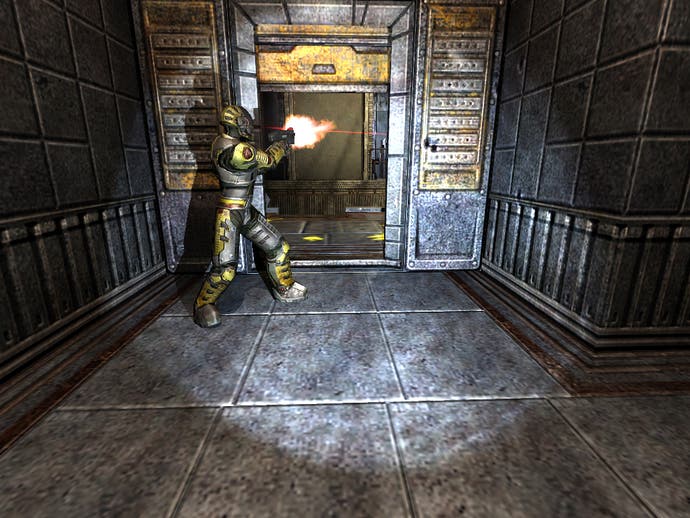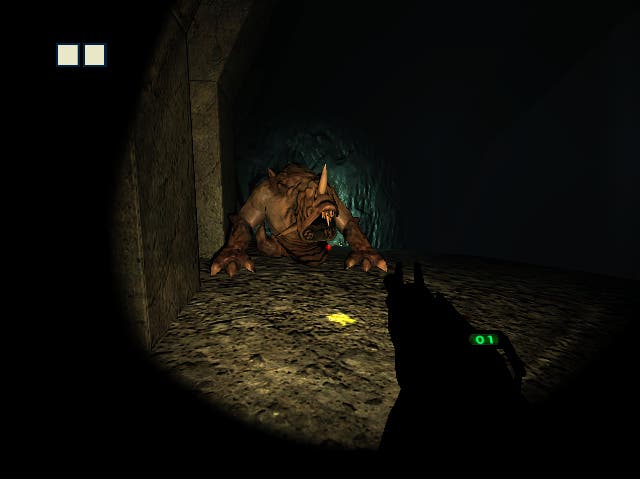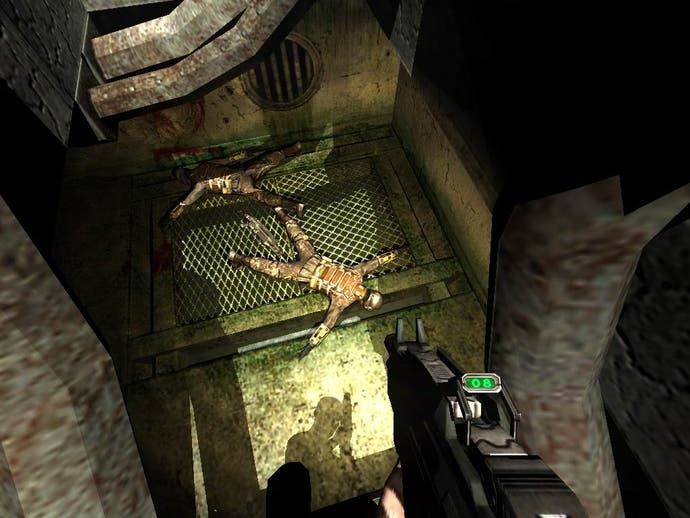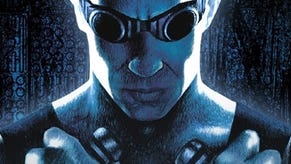The Chronicles of Riddick: Escape From Butcher Bay
Vindicated.
We told you so. No, not you, gentle reader - we never tell you anything that turns out to be true. No, we told you so, Mr. Games Publisher. We told you numerous times. And now we're right. Riddick makes us right. The key to making a successful game out of a film is exactly what we, and just about every other games journalist on the planet, have been pleading with you to do all along! You stop making games out of films!
Sure, you can make a fair buck out of something with a big name, but by sticking doggedly to the events of the film you're just filling the same void as those books people write which follow screenplays shot for shot. Unless you're a 12 year-old trying to get in to see Kill Bill, and nobody will pretend to be your Dad, why would you pay to read a blow-by-blow account of a predominantly visual experience? And to be fair to the people who write those books, games of films barely come close to your accomplishments.
The Chronicles of Riddick: Escape From Butcher Bay is different. While there is a film due out at the end of August called The Chronicles of Riddick, not only do the two have virtually nothing in common in terms of plot (and even characters), but there's actually an entire film called Pitch Black that occurs in-between them. And rather like that film, Escape From Butcher Bay is a self-contained story that touches gently upon a broader context without ever fully revealing it, but proves thoroughly entertaining regardless.
Pitching up

Simply put, Riddick has been brought to a prison called Butcher Bay by a bounty hunter named Johns. Johns aims to pay off a debt he owes to the warden, greasy Chesney Hawkes look alike Hoxie, by surrendering his much-sought-after charge into his custody, but from the moment Riddick arrives he has other ideas. By doing favours for other inmates and fighting his way past the guards, he hopes to escape. And while other factors come into play - some that make sense if you saw Pitch Black, some that won't until Chronicles takes a bow - generally speaking, our bald-headed anti-hero does exactly what it says on the Vin. Sorry, tin. Sorry, box.
The manner in which he does this differs from what we've come to expect not so much in terms of mechanics, but in terms of variation. A brief prologue chapter introduces us to each aspect of the game individually, teaching us how to climb over objects (X), sneak up behind enemies (left thumb stick click to crouch, with a nice fish-eye effect - tinted blue whenever Riddick is out of sight) and then grab them (left trigger) and break their necks (quietly, by hammering X, or loudly, by tugging the right trigger), fight them hand to hand (left trigger to block, and right trigger to swing a punch directed using the left thumb stick), shoot them (normal Halo rules apply), or even talk to them (pressing X whilst a character's name is highlighted). And over the course of the game each of these disciplines comes in handy.
A lot has been made in recent months of the fact that developer Starbreeze chose to employ a large number of different gameplay mechanics throughout the game, but in truth it's the manner in which they combine that keeps us interested. Individually, the hand-to-hand combat, stealth killing, running and gunning and adventure elements are all nicely done, but they wouldn't fill up their own games - or if they did they wouldn't be very interesting games.
But when you discover that failed stealth kills segue neatly into fist fighting, or sneak up expertly and slice a guard's throat and then realise you've been spotted, only to wheel round and load someone's face full of buckshot, it becomes clear that the fluency is the star. Some sections may focus on one particular discipline more than any other, but the transition is rarely contrived, and the simplicity of the controls means that you're rarely at a loss for what to do when forced to improvise in a tight spot.
From our perspective

The first-person perspective is another critical inclusion for a number of reasons, and an unusual one for a film licence. Plot-wise, the idea is that Riddick is locked away in a prison, and he wants to get out. Playing from Riddick's perspective, rather than leering over his shoulder, preserves the claustrophobia of Butcher Bay's cramped environments, and adds a greater sense of urgency and trepidation to tense encounters.
It also helps give us a sense of 'being' Riddick. Of course we're seeing things from his perspective, but coupled with some very ambiguous, coolly delivered dialogue (from Vin Diesel himself), the perspective gives us the sense that we really are Riddick. We're not just riding along. And, whether deliberately or not, the emotionless physical acting of the character in cut-scenes manages not to spoil the effect. In a sense, Starbreeze has made us the character, and still managed to deliver an adventure featuring a well-known hopes-to-be movie icon.
Impressively, the developer even knows when to give up on the first-person perspective. Whenever Riddick's climbing a ladder, or dangling from an overhead wire, the game cuts to a third-person view - it doesn't endanger your character particularly to do so in these situations, and it neatly sidesteps the common issue with first-person climbing and dangling, namely that it usually looks crap.
Aided by a responsive dual-analogue control system which is easy to aim (even if it could probably do with accelerating a little bit quicker away from the centre), a sensible checkpoint system that rarely forces you to replay more than a minute or so after death, and a Halo-style health system that recharges partly if you can avoid confrontation for a spell (and increases in capacity at intervals), all of this amounts to one of the most comfortable prison experiences anybody's ever likely to have.
Change is good

Making your way through the game is pleasurable, not tiresome, even though you rarely do much beyond what you learn in the opening minutes. In fact, that opening snapshot of the game arguably inspires you to keep going, because it's only by persevering that you get to explore each element in its entirety. The adventure-like aspect of talking to inmates and earning respect through favours and actions gradually builds up until you affect some form of escape, forcing your way outside the bounds of the general population and having to rely on stealth, hand to hand combat and eventually balls-out blasting to proceed. Individual sections, like the floor of the mines where you have to carve a silently violent passage past numerous patrolling guards, prove memorable not because they're particularly innovative, but because you're not just repeating the same actions for the 400th time to make progress.
There is repetition. There is backtracking. But both are handled well enough that neither is a problem. Having faced similar scenarios so many times in the past, we found ourselves groaning a little when asked to make our way all the way back from the depths of the mines to the 'Double Max' facility halfway back towards surface, only to discover that our subsequent path proved quite different - and wasn't forced upon us either. We came down one way, and wound up going back another. Asked to go back to the bottom of the mines again, we wound up taking another route. The game is quite linear, but there is a sense that you're finding your way around, and the travelling rarely becomes boring.
Riddick never seems happy to rest on one particular idea. At intervals the game introduces new things, like a Tranquiliser Gun, which eases progress when multiple enemies are in the way and there's no time to pick a considered path, and the "EyeShine" ability, which enables Riddick to see in the dark (something accentuated visually in a manner reminiscent of the Alien view in Aliens Vs. Predator). It plays with the rules, forcing you to ignore virtually every assault rifle in the game unless you've managed to get your DNA into the prison's mainframe computer. It even changes pace and setting, guiding you from wannabe Sam Fisher into Gordon Freeman's spectator-with-a-gun when a particular event triggers the introduction of another, deadlier adversary.
Uncharted territory

Perhaps not everyone will appreciate the structure as much as critics who've been crying out for something like this for so long. But one of Butcher Bay's universal pleasures is that it looks gorgeous. The visuals, which employ techniques we'll be hearing lots more about over the coming months and years, are of the sort of calibre you wouldn't normally associate with consoles - even Xbox. A lot of the credit in particular must go to one feature, called 'normal mapping', which allows the developer to plaster the walls of Riddick's prison playground with 2D textures that look like and react to light as though they are three-dimensional.
As a result, even the least important nooks and crannies are drenched in detail. Walk into an elevator and admire the piping, perhaps stroking your shotgun's torchlight across it in disbelief, and it seems inconceivable that what you're actually looking at is a flat, two-dimensional piece of artwork. It just happens to know what to do when light hits it. And the lighting effects certainly play their part - whether it's through flaming debris dancing away from explosions and scattering flashes of light across the grimy interiors, the aforementioned torchlight clutching at the gloom ever so convincingly, or by casting real-time shadows across just about anything you could care to mention. In fact, Riddick's shadow is arguably more charismatic than he is.
We could, in all honesty, bang on about the visuals for longer than it takes to complete the game, so we'll stop soon, but not before we've paid tribute to the misty air wafting through ventilation shafts and onto our list under the heading of 'atmosphere', the variation in visual style from section to section (even within a single prison environment), and above all the animation. Enemies move convincingly (and it takes a lot to persuade us that ED209/Warhammer Dreadnought wannabe robots look 'convincing'), and Riddick himself could quite happily stand up in a third-person game. And crouch. And jump. And climb. Etc.
Model behaviour

Shot from the third-person perspective in cut-scenes and during those little climbing cutaways, his character model captures Vin Diesel's form beautifully (inasmuch as it can in any event), but it's the authenticity of his movement that's surprising. Cranking a ventilation shaft cover and opening it, he grabs hold of the rim and gently springs inside. Jumping from a platform onto a moving container whilst under fire, and calmly dangling from the opposite side to evade flying lead, he has the same calm, unflinching demeanour as the man himself, and that's a very tough thing to emulate.
All this detail does occasionally cost you a few frames per second, but we'd say the game never dips below 30, and it would be harsh to criticise it on this count anyway because it's such a phenomenal technical achievement. The technology is one of the key components. And a native widescreen mode - and even progressive scan in the American version - more than makes up for any shortfall in framerate.
There are, however, a few things we could do with waggling our fingers at before we pass down a verdict. On the niggly side of things, there are some animation glitches (very occasionally some of our stealth kills looked a bit awkward), we sometimes found we clicked the crouch button by accident during combat (damn our hands), the one-button inventory switching isn't always ideal, the map isn't very useful, some of the level design towards the end is a little boring, and the third-person cutaways in darker areas don't respect the EyeShine toggle, meaning that you go from Alien-style glow-in-the-dark view to pitch black whenever you climb over a crate. But obviously we feel these issues are forgivable.
Where is my mind?

Slightly more annoying is the enemy AI, which, whilst not ostensibly bad, is one of the weaker elements. Enemies react based on a combination of what you're up to and where they are, but they don't often behave particularly intelligently. Dreadnought-style metal suits sometimes stomp around on the spot when they fail to find a direct path back to their patrol routes, and guards generally fight you from a distance by shooting for a while, doing a ridiculous sideways roll and then shooting at you again.
But then these grunts are mostly just there to die - and the game's about killing them, not often evading them, so we can live with their inefficiency. More worrying are the very occasional boss encounters, which are decidedly poor - your first clash with one recurring bad guy sees him soak up countless shotgun shells to the chest before surviving to come back and outstay his welcome in a separate encounter later on. For a game that models facial bruising accurately, an invincible guard stands out like a hair on Vin Diesel's head. The last real boss fight, meanwhile, actually takes place about 45 minutes prior to the end sequence, and proves rather unsatisfying for other reasons we won't go into.
Then again, what follows could be described as a satisfyingly fiery denouement, and involves a surprising change of setting and breaks out some enjoyable exotic hardware to boot. Perhaps the boss fights aren't particularly significant after all. No, if there is a major overall criticism, it's that the game is so self-contained that Pitch Black fans may feel they haven't learnt a great deal from it - although it ties up all its own loose ends (some satisfyingly, some not), it doesn't really delve too far into Riddick's back-story other than specifically addressing his time at Butcher Bay.
Sparkling
But while there are certainly grains of sugar in the Diesel tank, it's not enough to blow the whole thing sky high. Taken as a whole, Riddick's ten-hour adventure is often masterful, rarely boring, and beautifully presented - from the minimalist HUD and maximalist visuals to the reactive Gregson-Williams-inspired scoring and conversational feel of the dialogue. It is a critical darling because it dares to keep changing and still manages to maintain a high standard in spite of this. It satisfies our lust for variation and our lust for technical excellence. And although it doesn't always do it perfectly, it does it well enough to earn £40 of our money.



